Drip Email Campaigns: Best Practices, KPIs, and Examples
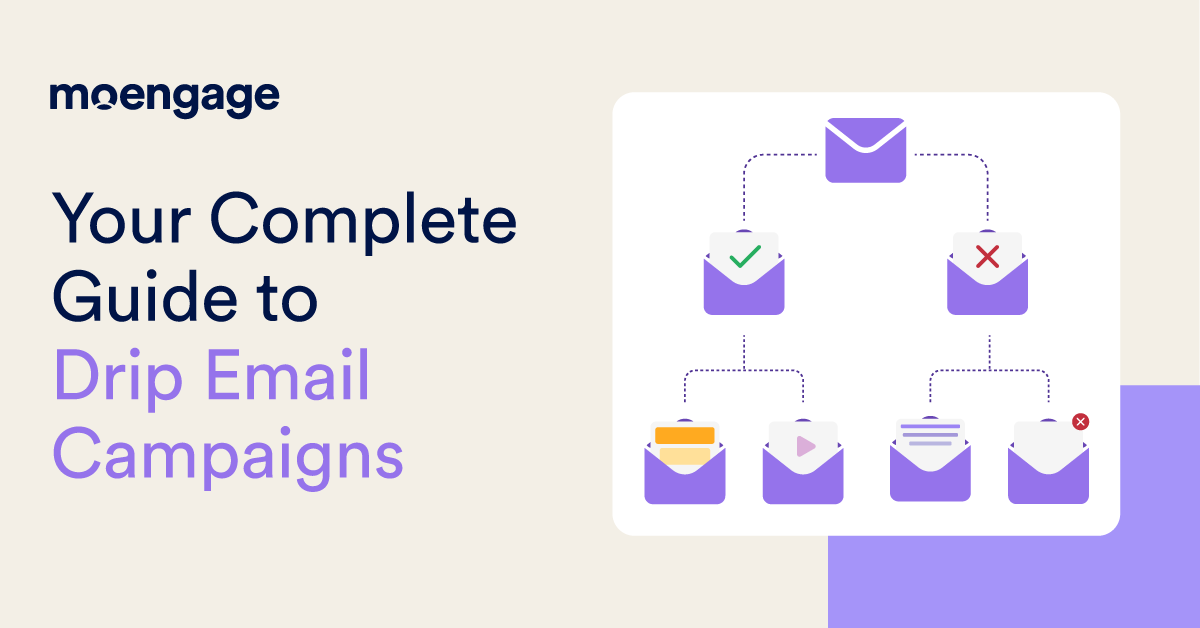
Reading Time: 15 minutes
You’re loyal to a brand. You follow them on social media, shop in their stores, and check their website for deals.
Naturally, you sign up for their newsletter, expecting the same great experience.
But then… nothing.
No welcome email. No personalized offers. Just generic updates that don’t reflect your shopping habits. Is this what it feels like when a brand you’ve been loyal to for years no longer recognizes you?
This is where drip email campaigns should shine. Done right, email marketing drip campaigns nurture relationships, create personalized touchpoints, deliver behavior-based recommendations, and drive effortless engagement.
Yet, many brands miss the mark. So, where do you start? How much effort does it take beyond a standard email? And how do you set it up for success?
Let’s break it down into strategy, execution, and everything in between.
What Is An Email Marketing Drip Campaign?
A drip email campaign consists of automated emails activated by a specific action on a brand’s website. The brand can regulate the number and timing of emails, personalize their content, limit their frequency, and implement combinations to drive engagement or convert leads effectively.
A well-crafted drip campaign ensures every interaction is relevant, guiding customers seamlessly from sign-up to conversion. This powerful tool can be used in various scenarios, such as onboarding a new customer, sending a reminder for subscription renewal, or addressing cart abandonment.
It’s a strategic way to engage your audience and drive conversions.
Imagine you’re a B2C SaaS brand (like Canva), looking to create an onboarding flow that welcomes new customers and uncovers their preferences from the get-go. You start by asking them questions to understand their needs. Then, you analyze their interactions with key CTAs to gauge interest. Finally, you measure engagement levels through each step, refining the customer journey based on their responses.
By the end, you’ve collected valuable insights into their interests and buying intent, setting the stage for effective B2C email marketing through personalized communication and tailored offerings.
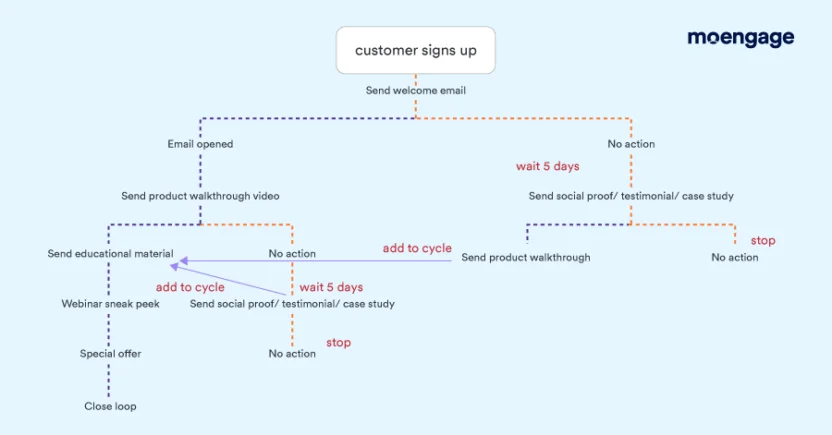
At each touchpoint, the brand can optimize content, stop the flow if the customer is not interacting, share valuable resources for onboarding, and allow the customer to feel at ease.
How Many Emails Should Be In a Good Drip Campaign?
A staggering 3.3 million emails flood inboxes every second, so how can brands cut through the noise? A standard drip campaign typically consists of 3 to 7 emails to strike the right balance for engagement, but an ideal number depends on your industry, audience, and business goals.
- A welcome email series can span 7-10 business days to introduce the brand and drive the first action with 3-5 emails.
- Engagement emails or lead nurturing campaigns can be spread across weeks or months to educate the audience.
- Retention emails are ideal when they touch base 4-6 times with great offers, USPs, and social proof in 10-14 days to re-engage inactive customers.
- Cart abandonment emails must be sent within 48 hours to recover lost sales and capped at 2 emails.
- A loyalty or rewards campaign can comprise 4-6 emails over a quarter or more to reinforce brand affinity.
While there’s no strict rule against sending more emails, overwhelming your audience can backfire. The key is to maintain relevance without exhausting attention. Space out your emails, A/B test for the right messaging, and keep your content crisp yet impactful.
Why Run Drip Email Campaigns?
According to 63% of email marketers, the volume of marketing emails sent is rising. To keep up with this growing demand, more marketers are turning to drip campaigns to build long-term relationships with minimal effort. Let’s explore how drip email campaigns can help you achieve your business goals:
Staying relevant
4 out of 5 marketers say they would give up social media marketing rather than email marketing. That’s because emails keep your brand top-of-mind by creating a real-time, conversational experience—meeting customers exactly where they are in their journey.
With a drip sequence, brands can trigger customer action by exploring the brand, purchasing, or deepening product familiarity. They ensure that every touchpoint moves customers closer to conversion.
Increasing efficiency
One of the benefits of email marketing through drip campaigns is efficiency. With an email drip campaign, moving customers from one stage of their journey to another becomes more straightforward. By automating this journey, you can eliminate friction, reduce decision fatigue, and maintain engagement—all by making the buying process smooth and intuitive.
Being engagement-driven
When your customers can expect what’s coming next—an onboarding step, a discount, an introduction to a new feature—they engage more with your brand. By aligning your content with customer intent, you can create a frictionless, enjoyable experience that keeps them returning to your brand.
Personalizing communication
The power of a drip email campaign lies in its precision and hyper-personalization—it delivers highly relevant messages to the right audience at the right time. Instead of blasting emails to your entire email list, you engage with only those to whom the conversation truly matters.
Being resourceful
Each email sent via an email drip campaign can be highly action-driven, customized, and targeted. Drip campaigns can nurture leads, present personalized material, and highlight the brand intuitively. With the right marketing tools, you can count on your communication and email marketing automation to make a difference.
6 Steps to Designing Engaging Drip Email Campaigns
98% of Millennials and Gen Xers rely on email more than any other generation for communication. Thus, at this point, businesses of all kinds can extract immense value out of an email drip sequence if done right.
Let’s understand how you can get started.
1. Define your goal
Are you nurturing your leads? Resurrecting an old customer base? Onboarding a new client? The use cases are innumerable; however, the onset of each lies in setting up your campaign goal.
For example, how many emails will you send and at what frequency? What would be the best time to send the emails?
2. Segment audience
Another key to the success of your drip campaign is working with audiences that share a similar pattern (behavior, industry, past purchases, or engagement level). This allows you to get creative and on point with your communication. By understanding your audience, you can tailor your messages to their needs and preferences, making them feel valued and considered.
For example, new sign-ups receive onboarding emails, while active customers get a feature update email.
3. Map the customer journey
The most crucial step is to craft your customer’s journey and identify the key moments when and where automated emails can guide your customers to take the following action.
For instance, a product tutorial or an actual customer success story after a sign-up would be a nice touch.
4. Craft your content
The good news is that 60% of consumers prefer to be contacted by brands through email. So, you have to optimize your content to keep it short, relatable, and worth your customers’ time.
Always go back to your analytics to check the email performance, see what worked better than the rest, and use the data to drive future marketing decisions.
The United States, for example, remains the highest spender on digital video ads. So, if your audience is based out of the US, add a video in the email or redirect your audience to the video.
5. Optimize for success
After you’ve locked down what you’ll say, the next best decision is when and how often. Space out your emails strategically to engage without overwhelming your customers. Experiment with different subject lines, content, CTAs, and sending times to maximize impact.
For example, set two onboarding sequences – one with a webinar invite and the other with a product walkthrough.
6. Measure and refine
Rolling back to point one, once your goal is defined, come back to track it over days, weeks, or months. Start with email open rates, CTRs, and conversion rates, then go deeper to touch point engagement metrics to optimize future campaigns (more on that below).
For instance, check out this image of your email campaign analytics. In the MoEngage dashboard, you have plenty of options to play with the visualization.
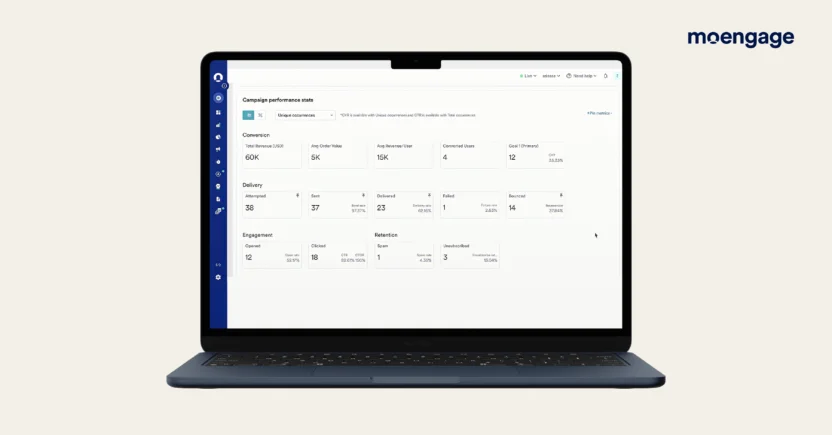
Drip Email Template: How to Sequence Your Drip Email Campaign
The core components of designing an email drip sequence are identifying your email triggers, setting your goals, and deciding the next action step. Too much? Let’s break it down.
To set up an email drip sequence, you need to lock the trigger for your campaign. This will begin your campaign and can be tagged as an action. For instance, common triggers a B2C brand uses are:
- First-time purchase > Thank you email + personalized recommendation
- Abandoned cart > Reminder email + limited discount
- Browsing but not buying > Retargeting email with social proof
- Repeat purchase > Loyalty reward email + early access to new arrivals
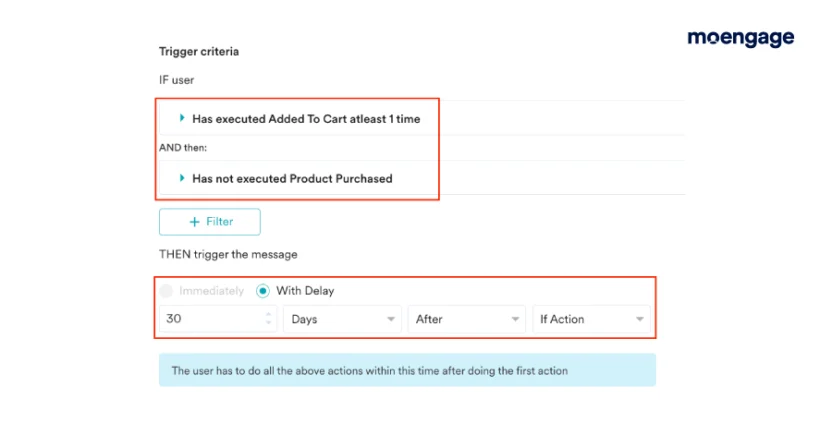
MoEngage lets you set event triggers with multiple conditions. For instance, in the above image, if a customer adds a product to the cart but doesn’t purchase it within 30 days, the condition would be: “If the user adds to the cart AND hasn’t purchased within 30 days, trigger the message.”
As discussed earlier, your campaign goal will define the nature of your campaign and ensure that every email has a clear purpose and moves the customer further down the funnel. Some of the most common goals for email drip campaigns are:
- Increase conversion rate
- Encourage new purchases
- Product discovery
- Reduce churn
Once your goal is set, decide your action. Every customer action is tagged to a trigger and should prompt the drip to communicate. Without a clear next step, your campaign will not meet its mark. Here are a few examples:
- Trial user sign up > Send content for how to use + bestsellers
- First purchase > Personalized recommendation > Increase AOV
- Cart abandonment > Give an offer > Add to loyalty program
Let’s consider a hypothetical brand: FitLife, a subscription-based fitness app. They recently started a loyalty drip campaign to reward their customer base with offers on special days.
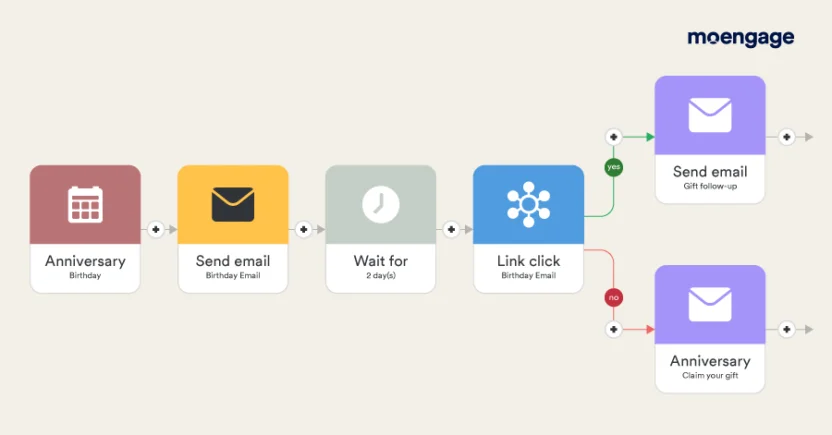
The primary trigger here is an occasion such as birthdays or anniversaries, and sending them a voucher makes them feel valued and recognized.
Pro tip: The tool you use to send out your campaigns is crucial to your success. A modern, trend-savvy platform that offers innovative ways to engage with your audience will always give you an edge over your competitors. MoEngage, with its advanced email marketing automation features, helps you stay ahead of consumer trends and ensures you connect with your customers in meaningful ways.
When done right, drip emails can skyrocket conversions. But not all drips serve the same purpose. From lead nurturing to re-engagement, different types of drip campaigns deliver positive results.
5 Different Types of Drip Emails to Include In Your Campaigns
There’s no denying that email is a solid tool compared to other marketing levers. In fact, according to DMA, for every $ spent on email, the potential ROI is $42. So, while you decide to go full throttle on email drip, here are five types of drip emails to include in your campaigns.
1. Welcome Emails
As easy as it gets, automated welcome email campaigns are the foundation of your relationship with the brand. It sets the tone for your future emails. It is also an opportunity for a brand to educate customers.
The best way to utilize it is to share a quick how-to, a sneak peek into your best work, success stories, etc.
2. Engagement Emails
Keeping your audience engaged is crucial. Whether nurturing an active customer base or reactivating a dormant one, engagement drip emails are significant touchpoints that keep the brand on the top shelf.
The best way to utilize this is with personalized recommendations, exclusive offers, content, and a friendly check-in.
3. Abandoned Cart Emails
A customer showed buying intent but did not complete the purchase. Now what? Should you just let that be? The average conversion rate for cart abandonment messages is 17.12%, which is superb if appropriately used.
The best way to utilize it is to include a timer to drive the purchase, share social proof, and reduce the buying journey to fewer steps.
4. Lead Nurturing Emails
Not all your leads will purchase as soon as they learn about you, especially in SaaS, where sometimes the back-and-forth can go on for months. Thus, a drip campaign that educates, builds trust, and helps potential customers move down the funnel over time is incumbent.
The best way to utilize it is to share testimonials, success stories, free access, and valuable content that helps decision-making.
5. Upsell or Cross-sell Emails
Purchase is not the end of the customer journey; selling products to existing customers is better for brands. Upsell and cross-sell emails introduce complementary products, services, upgrades, or higher-tier plans.
The best approach is to recommend products based on past purchases, showcase bundle deals, or highlight premium features with clear benefits.
In fact, Ecommerce brands saw a 3% conversion rate from automated welcome emails in 2022, while cart abandonment emails drove a 2.39% conversion rate, proving the power of well-timed, targeted automation.
5 Email Drip Campaign Examples From Masterful Brands
Now, look at a few high-impact drip email examples and how they’ve delivered results for famous brands.
1. Apple: Upsell email
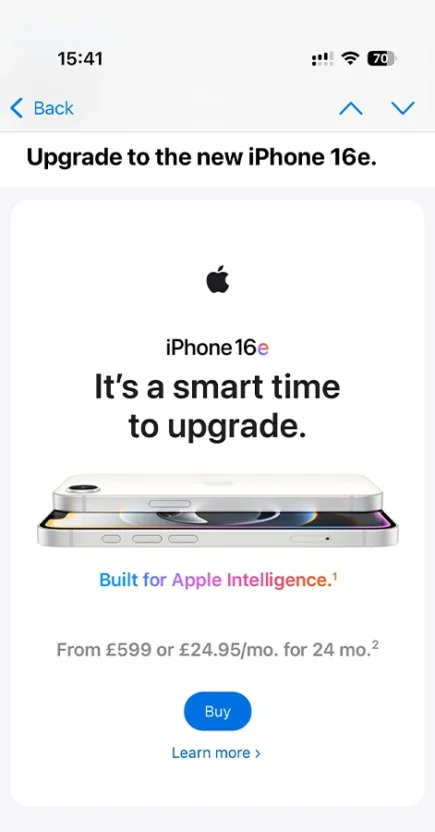
Apple’s marketing is a masterclass in persuasion. Their product launch emails don’t overwhelm with details—instead, they plant a simple yet powerful idea: *It’s time to upgrade.*
Sitting on a massive email list of users who signed up with their Apple IDs, Apple knows precisely which device each customer owns. When a new product launches, they send hyper-targeted emails nudging users toward an upgrade. The impact? They’re speaking directly to people already invested in the Apple ecosystem—those most likely to buy.
2. Sephora: Engagement email
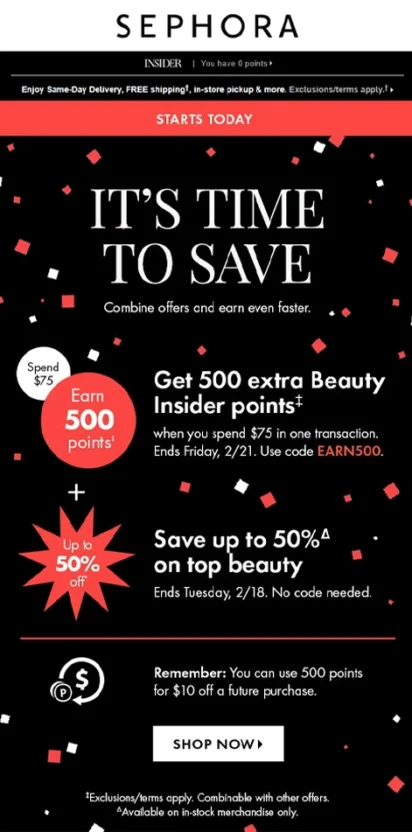
Sephora’s monthly engagement email to active shoppers and dormant users is designed to drive sales with a well-timed offer. It is the perfect nudge to return for those who haven’t purchased in a while.
For active shoppers, it reinforces buying behavior, making them feel compelled to shop again. By balancing reactivation with retention, Sephora keeps customers engaged and spending.
3. FILA: Product launch email

FILA taps into the Hailey Bieber trend with an innovative collaboration, promoting it directly to its audience through targeted emails. These emails match her aesthetic, highlighting the collection she endorses.
It works because FILA understands its audience—they know this trend resonates. The impact? Customers are eager to stay on trend, explore the collection, and indulge in the hype, making the campaign both timely and effective.
4. Casper: Cart abandonment
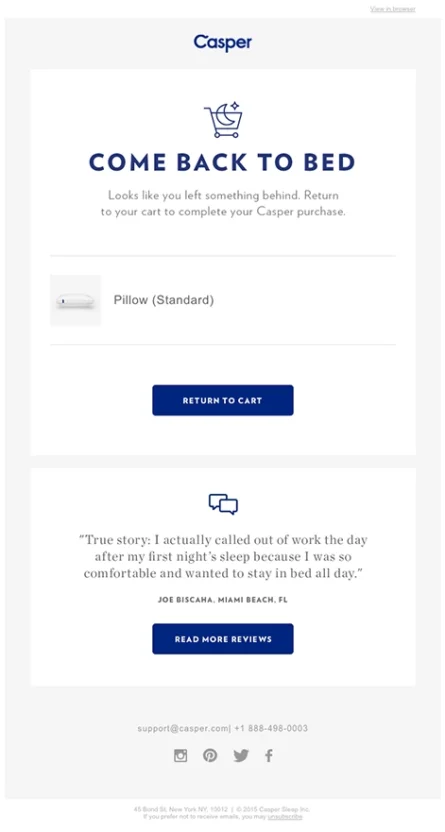
Casper’s cart abandonment recovery email is clever, well-timed, and impossible to ignore. The playful copy grabs attention, while the clear CTA nudges customers back to purchase. Timing is everything in these emails, and Casper nails it by striking when intent is high. The humor makes customers laugh and builds a positive brand connection, increasing the chances of conversion.
5. Audible: Cross-sell
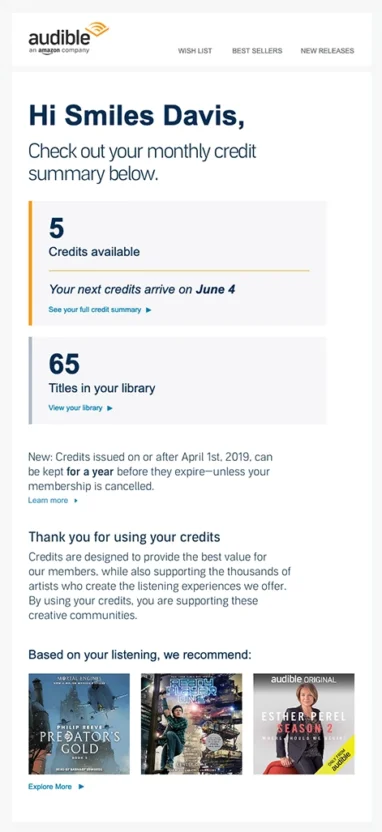
Amazon’s Audible leverages its vast customer data, tracking purchases, interests, and buying patterns to drive more intelligent recommendations. They remind customers of available credits, nudging them toward a purchase while suggesting books based on past purchases to make discovery seamless.
This approach works because cross-selling is more than just pushing additional products; it enhances the shopping experience with relevant, personalized recommendations. By tailoring suggestions, Audible boosts customer spending and builds stronger relationships, showing that it truly understands its users’ needs.
Top 5 Email Drip Campaign KPIs to Measure Campaign Success
The success of your email drip campaign lies in extrapolation. Once you send out your first campaign, tracking the right KPIs ensures engagement, conversion, and a high ROI. Here are five key drip email metrics to analyze.
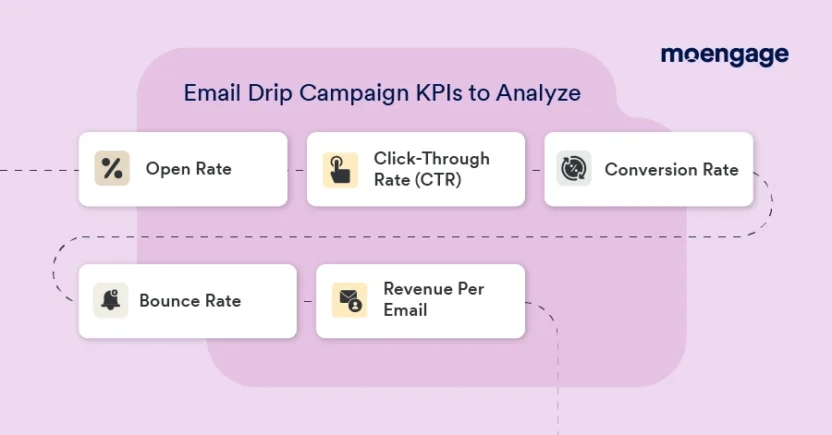
1. Open Rate
The open rate measures the percentage of recipients who open your email. Broadly, it is the first indicator of whether your subject line and sender reputation are on point. If your open rates are low, they reflect poor content, bad timing, a weak subject line, or a disengaged subscriber base.
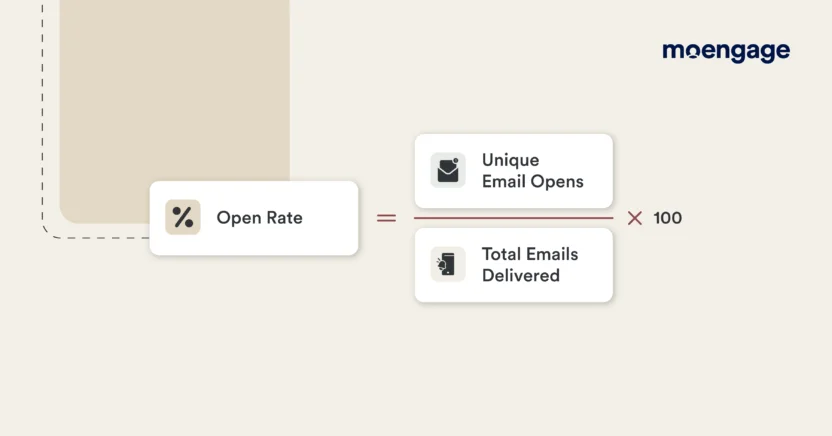
If you sent out 1000 emails with only 200 unique opens, your open rate would be 20%. This might indicate that the subject line, sender name, segmentation, or timing are ineffective.
Marketers can quickly identify if their subject line and overall messaging are enough to prompt recipients to open the mail by monitoring open rates. A/B testing, optimizing send times, and audience segmentation are encouraged to manage low open rates.
2. Click-through Rate (CTR)
The click-through rate measures the percentage of recipients who clicked on a link within your email. Now measured across the funnel, the click-through rate highlights the recipients’ interest in your communication. A high CTR shows a high affinity amongst receivers to take action.
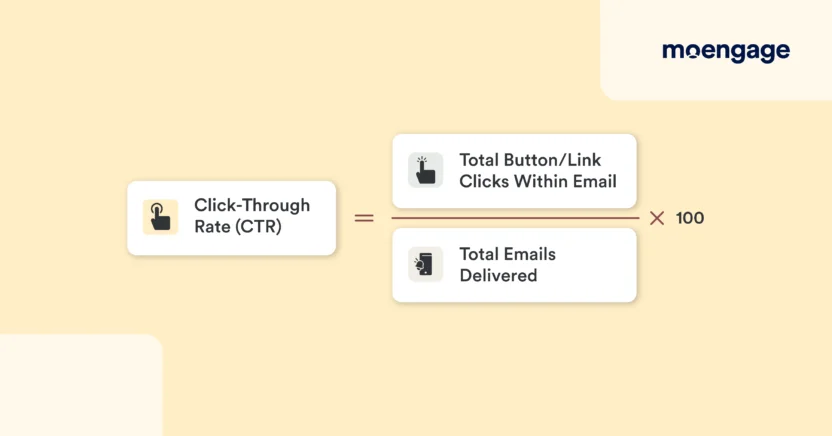
If you sent 1000 emails and got only 100 unique clicks, your CTR would be 10%. This indicates that your content is engaging but could use a more substantial, targeted approach.
Marketers can use CTR to gauge how their content resonates with the audience and whether their offers, copy, CTA, or email design are pervasive enough. Again, A/B testing can help you optimize your performance.
3. Conversion Rate
The conversion rate measures the percentage of recipients who complete the desired action after engaging with your email- whether downloading an e-book or signing up for a webinar. The conversion rate reflects efficacy. If conversions are low, reconsider your drip email sequence, landing pages, or offer.
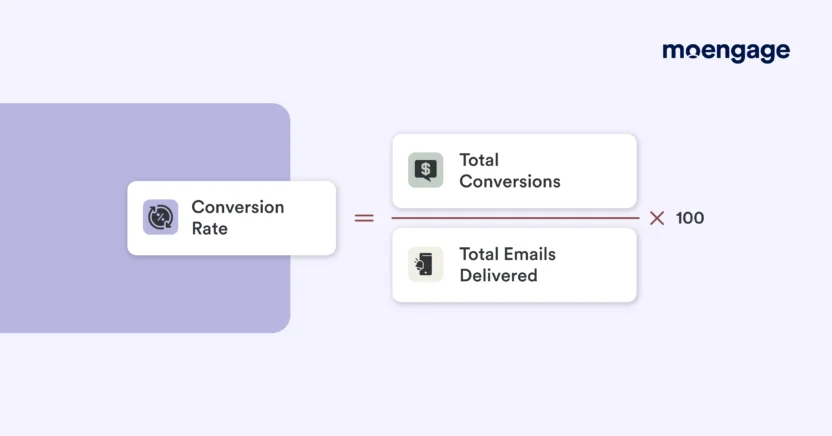
If you sent 1000 emails and only 50 recipients signed up for a webinar, your conversion would be 5%. Reexamining your engagement strategy, optimizing your landing page, or running an A/B test on your content and CTA might help in such a case.
Marketers can use conversion rates to measure the efficacy of their email in driving sales or business. A low conversion rate should prompt experiments with email sequence, content, or user experience.
4. Bounce Rate and Unsubscribe
The bounce rate measures the percentage of emails that were delivered or not. When you send out an email drip campaign and see many consumers leaving or unsubscribing from the funnel, it indicates a mismatch between your customers’ expectations and your content. To stay relevant, monitor the number of consumers in the funnel closely.
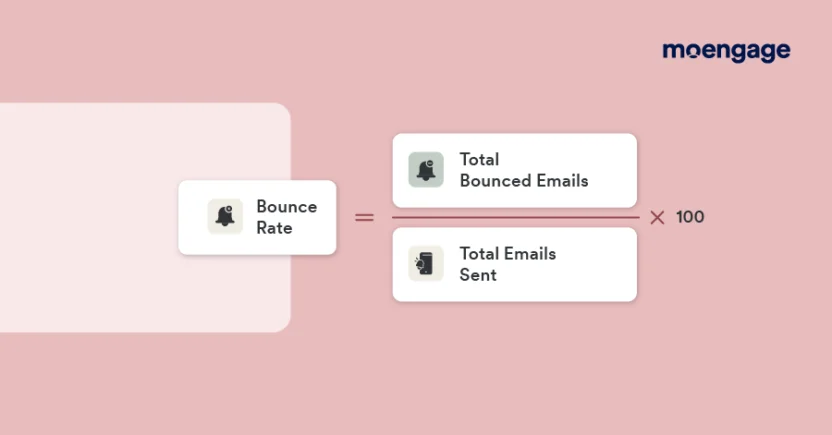
If you sent out 1000 emails and 100 bounced, your bounce rate would be 10%. You must clean your email list or address the delivery issue.
By analyzing bounce rates, marketers can get an idea of hygiene checks in cleaning their email lists and the timing and relevancy of content. A high bounce rate requires immediate action in revising content strategy or segmentation improvements.
4. Revenue Per Email
Revenue per email tracks the financial impact of your campaign, measuring how much revenue each email generates. This method is ideal for calculating long-term implications. If your drip campaign isn’t driving revenue, evaluate targeting, personalization, and offers.
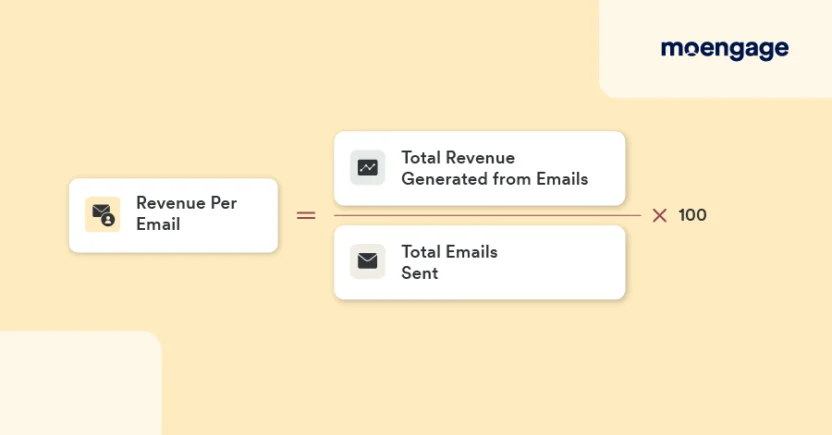
If you sent out 1000 emails and generated $500 in revenue, your RPE would be $0.50, which is usually considered a poor outcome. Optimizing your email list, working with better offers, or double-tapping your sales funnel might help.
Marketers can use RPE as a proxy to assess the financial effectiveness of their drip campaigns. A low RPE may indicate an issue with the offer, targeting, or email list.
While each marketer will pick different KPIs to measure success and dive deeper into the funnel, additional metrics like engagement rate or click-to-sale can also offer insight into assessing long-term impact. Then, there are a few metrics, such as the email deliverability rate and the spam score, to ensure the email hits the inbox.
Tracking unsubscribe trends can also reveal how well your campaigns nurture and retain customers. Refining these deeper metrics allows you to optimize your email drip campaign strategy for sustained growth and higher ROI.
5 Email Drip Campaign Best Practices to Reach Full Automation
How do automated drip email campaigns work their magic? They ensure the right people get the right messages at the right time — without the heavy lifting every time.
To maximize the impact of your effort, automation needs to be strategic, not just scheduled. Here’s what you shouldn’t miss:
1. Build your Ideal Customer Profile (ICP)
Before automating, know your drip campaign audience. Outline the customer journey. Identify their key pain points. Divide subscribers based on demographics, behavior, or preferences, and tailor content to each segment for increased relevance. Understanding your ICP enables you to deliver the most relevant email at the right customer journey stage. Tailored messages lead to better engagement and higher conversion.
2. Optimize timing and frequency
Sending too many drip email campaigns simultaneously can confuse and irritate customers, leading to less engagement. So, test different send times to find optimal engagement periods and balance the frequency to maintain interest without overwhelming subscribers.
Paired with the right automation, marketers can schedule emails to be sent based on specific engagement levels and test different frequencies (daily vs weekly).
3. A/B test your drip emails
Even with the convenience of automation, optimizing your email for the best outcome is always recommended. From your subject lines andCTAs to email length and fonts, nearly everything can be A/B tested and tweaked for peak performance.
With automation, marketers can use A/B testing for ongoing optimization without manual intervention. Once you set up tests for various email elements, the system can automatically deliver the highest-performing variation, driving incremental improvements over time.
4. Design for mobile
Mobile devices account for over half of web traffic, so it’s a big no-no if your email doesn’t load properly on a customer’s mobile device. Always use responsive design for drip emails to render correctly on various devices and keep content concise and easily scannable.
At a point when automation allows scale, losing an audience that consumes content on mobile is a massive miss. Therefore, create a mobile-friendly design to enhance customer experience and increase conversions.
5. Personalization
Brands use MoEngage to avoid landing emails in the customer’s spam or promotions folder and boost delivery by 30%. This is possible because MoEngage lets you intuitively drag-and-drop email elements or granularly customize templates with our HTML builder.
So, when you automate your next email campaign, remember to create contextually relevant emails that align with your customers or deliver unique content experiences with personalization.
MoEngage: A Customer Engagement-Driven Drip Email Marketing Software
MoEngage keeps you ahead of the curve. That’s why major brands have chosen us to drive their cross-channel marketing automation at scale. The success stories of SoundCloud and Poshmark are prime examples of how MoEngage drives impactful results.
With modern features like an intuitive drag-and-drop email builder, advanced segmentation, and real-time analytics, creating personalized, high-impact drip email campaigns has never been easier.
Ready to win? Schedule a call with our team today!
















